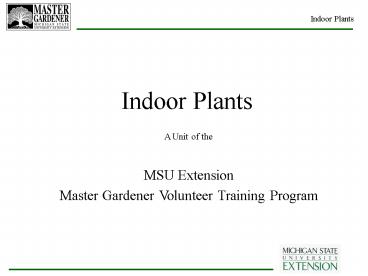Master Gardener Indoor Plants Unit - PowerPoint PPT Presentation
1 / 118
Title:
Master Gardener Indoor Plants Unit
Description:
Spider plant. Chlorophytum comosum. Parlor palm. Chamaedorea elegans. Cast-iron plant ... spider mites are eating me. white spots on leaves or stems. give ... – PowerPoint PPT presentation
Number of Views:1420
Avg rating:3.0/5.0
Title: Master Gardener Indoor Plants Unit
1
Indoor Plants
A Unit of the MSU Extension Master Gardener
Volunteer Training Program
2
Selecting Interior Plants
- Insect disease free.
- Healthy-looking from top to bottom.
- Match plant to indoor conditions.
3
Transporting
- Hot summer.
- Cold winter.
4
Acclimatization
- Moving Plants.
- Moving plants inside in winter.
- Moving plants outside in spring.
5
Plants as Air Cleaners
- Absorb air pollutants.
- Both the plant and the potting medium absorb the
pollutants.
6
(No Transcript)
7
Environmental Factors
- Light.
- Temperature.
- Flowering.
- Humidity.
- Ventilation.
8
Light
- Most essential factor for indoor plant growth.
- Three aspects of light to consider.
- Intensity.
- Duration.
- Quality.
9
Indoor Light Intensity Varies
- Location/Distance from source.
- Time of day.
- Latitude.
- Time of year.
- Cloud density.
10
Light Conditions
11
Light Requirements for Selected Indoor Plants
12
Light Quality
13
Photoperiodic Response (Duration)
- Short-day plants.
- Poinsettia, kalanchoe Christmas cactus.
- Long-day plants.
- Cineraria.
- Day-neutral plants.
- African violet.
14
Supplemental Light
- Quality of light.
- Fluorescent vs. Incandescent.
15
Incandescent vs. Fluorescent
16
Grow Lights
17
Temperature
- Affects productivity and plant growth.
- Manipulates flowering and plant height.
- Foliage Plants.
- Day 70 to 80 F.
- Night 60 to 68 F.
- Flowering.
- Day 70 to 80 F.
- Night 55 to 60 F.
18
(No Transcript)
19
(No Transcript)
20
Flowering
- Two critical stimuli that induce flowering.
- Day length.
- Temperature.
21
Day Length
- Short-day plants.
- Long-day plants.
- Day-neutral plants.
22
Temperature/Day Length
- Cool temperature/short-day.
- Cool temperature/long-day.
- Cool temperature/day-neutral.
- Warm temperature/short-day.
- Warm temperature/day-neutral.
23
Humidity
- Percent of the moisture saturation of air.
- Generally, 40 will be sufficient.
- 10 - 15 typical in Michigan homes in winter.
24
Humidity
- Increasing humidity
- Humidifiers.
- Humidity trays.
- Misting.
25
Humidifier
26
Humidity Tray
27
Misting
28
Ventilation
- Drafts.
- Forced warm air heat.
- Cold drafts - windows doors.
29
Containers
- Clay ceramic.
- Plastic fiberglass.
- Others.
30
Clay Ceramic
31
Plastic Fiberglass
32
Other
33
What must all indoor plant pots have?
34
Drainage
35
Media
- Artificial mixes.
- Soil mixes for certain plants.
- Sterilizing or pasteurizing.
36
(No Transcript)
37
Preparing Artificial Mixes
- Sphagnum Peat Moss.
- Perlite or Vermiculite.
- Ground Lime.
- Superphospate.
- 12-12-12 or something similar.
- Chelated Iron.
38
Repotting
39
Repotting
40
Repotting
41
Watering
- When to water.
- Water quantity.
- Water quality.
- Methods of application.
- Special considerations.
42
Fertilizing
- Advantages.
- Disadvantages.
- Timing of applications.
43
Training and Grooming
- Pinching.
- Pruning.
- Disbudding.
- Training on trellises.
- Cleaning.
44
Indoor Plant Problems
- Physiological Disorders.
- Insect.
- Mites.
- Diseases.
45
Physiological Disorder
Excess Soluble Salts
46
Physiological Disorder
Sun Scald
47
Physiological Disorder
Temperature Extremes
Heat
Cold
48
Physiological Disorder
Over or Under Watering?
49
The plants we use for house plants are subject
to the same insect and disease pests as any
other plants.
50
Insect Pest
- Scale.
- Mealy bugs.
- Fungus gnats.
- Aphids.
- Spider mites.
- Whiteflies.
51
Aphids
52
Spider Mites
53
Thrips
54
Whitefly
55
Mealy bugs
56
Scale
57
Fungus Gnats
58
Diseases
59
Root Rots
60
Powdery Mildew
61
A healthy plant will resist insects diseases
better than a stressed plant.
62
Pest Management
63
The key to any pest management is an accurate
identification or diagnosis.
64
(No Transcript)
65
Monitoring
- Scouting.
- Trapping.
- Weather.
- Degree days.
66
Types of Management Strategies
- Biological.
- Cultural.
- Chemical.
67
Biological Control
- Predators.
- Parasites.
- Pathogens.
68
(No Transcript)
69
Chemical Control
- Least Toxic Products.
- Horticultural Oil.
- Insecticidal Soap.
- NEEM Oil.
- Follow All Label Instructions.
70
Propagating Indoor Plants
71
Propagating Indoor Plants
- Sexual propagation.
- Vegetative propagation.
72
Sexual Propagation
- Seeds.
73
Vegetative (Asexual) Propagation
- Spores.
- Division (Separation).
- Air layering.
- Cuttings.
- Runners, Stolons Rhizomes.
74
Spores
75
Division
76
Runners Stolons
77
Air Layering
78
Cuttings
- Stem Cutting
- Leaf Cutting
- Whole Leaf.
- Leaf Sections.
- Leaf-bud cuttings.
- Leaf piece.
- Entire leaf blade and petiole.
- Entire leaf blade with cut veins.
- Viviparous leaves.
- Succulent/Cacti.
79
Seasonal Potted Plants
- After-flowering care.
- Care of special potted plants.
80
Poinsettia
81
Azalea
82
Gardenia
83
Amaryllis
84
Christmas Cactus
85
Cyclamen
86
Specialized Indoor Gardens
- Terrariums.
- Dish gardens.
- Bonsai.
- Topiary Standards.
87
Terrarium
88
Dish Garden
89
Bonsai
90
Topiary Standard
91
Common Indoor Plants
92
Aglaonema modestum (Chinese Evergreen)
93
Aspidistra elatior (Cast-iron Plant)
94
Chamaedorea elegans (Parlor Palm)
95
Monstera deliciosa (Split-leaf Philodendron)
96
Sansevieria trifasciata (Snake Plant)
97
Schefflera actinophylla (Umbrella Tree)
98
Cissus rhombifolia (Grape Ivy)
99
Dieffenbachia amoena (Dumbcane)
100
Dracaena fragrans (Corn Plant)
101
Ficus benjamina (Weeping Fig)
102
Ficus elastica (Rubber Plant)
103
Ficus lyrata (Fiddle-leaf Fig)
104
Hedera helix (English Ivy)
105
Nephrolepsis exaltata (Boston Fern)
106
Philodendron selloum(Split Leaf Philodendron)
107
Saintpaulia species (African Violet)
108
Spathiphyllum (Peace Lily)
109
Aloe barbadensis (Aloe Vera)
110
Araucaria heterophylla (Norfolk Island Pine)
111
Crassula argentea (Jade Plant)
112
Platycerium bifurcatum (Staghorn Fern)
113
Hibiscus rosa-sinensis (Chinese Hibiscus)
114
Schlumbergera spp (Christmas Cactus)
115
Peperomia
116
Scindapsus aureus (Devils Ivy, Pothos)
117
Hoya carnosa (Wax Plant)
118
Philodendron































